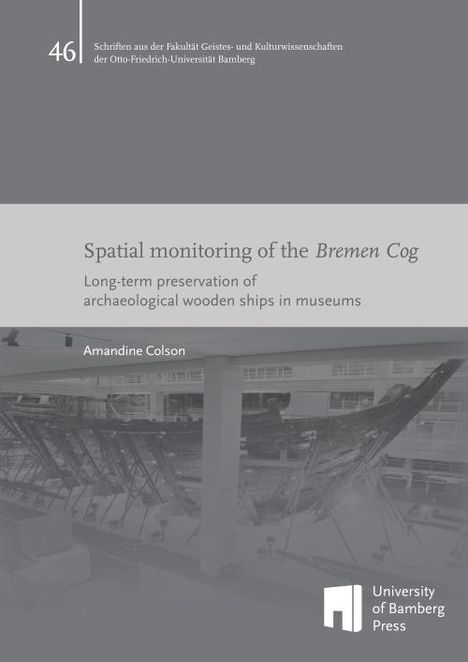Amandine Colson: Spatial monitoring of the Bremen Cog, Kartoniert / Broschiert
Spatial monitoring of the Bremen Cog
- Long-term preservation of archaeological wooden ships in museums
- Verlag:
- Otto-Friedrich-Uni, 06/2024
- Einband:
- Kartoniert / Broschiert
- Sprache:
- Englisch
- ISBN-13:
- 9783863099534
- Artikelnummer:
- 11902859
- Umfang:
- 255 Seiten
- Sonstiges:
- Ill., graph. Darst., Kt.
- Gewicht:
- 628 g
- Maße:
- 237 x 168 mm
- Stärke:
- 17 mm
- Erscheinungstermin:
- 4.6.2024
- Serie:
- Schriften aus der Fakultät Geistes- und Kulturwissenschaften der Otto-Friedrich-Universität Bamberg - Band 46
- Hinweis
-
Achtung: Artikel ist nicht in deutscher Sprache!
Klappentext
This research was conducted as part of a three-years-doctoral fellowship funded by the German Maritime Museum (DSM), Leibniz Institute for Maritime History, in Bremerhaven (Germany). The goal set up by the institution was "to investigate the possibilities and limits of non-invasive documentation technologies to study long-term behaviours of large-scale museum objects; in cooperation with the engineering research field and the industry, in order to answer conservation-restauration issues." Using 3D technologies to look at the deformation(s) on the Bremen Cog, 14th century-wooden vessel on display at the DSM, is an original idea from the author alone. After several years of 'standstill', the question of building an adequate support for the ship came back into the foreground and was discussed during a workshop organised by the museum in November 2013. All experts present agreed that nothing could be proposed without knowing more about the object's current conservation state. The structural weaknesses had to first be identified and understood in order to design the new support. Since wood can be considered as a 'living' entity, the question of deformation was essential, to slow down crack formation and anticipate breakage. Monitoring the geometry would help to understand all types of deformations involved in the process, for example seasonal changes as well as more linear and continuous deformation jeopardizing the structure over the long-term. This is how the journey began. But it took several months for the idea to take root and become reality. Thanks to the participation of Dr. Ursula Warnke, former DSM director, the author was invited in early 2014 to the COST-Action "Colour and Space in Cultural Heritage" COSCH. This platform became an extraordinary opportunity to gain access to specialists and knowledge in the field of 3D technologies, and to be exposed to new ideas. The role of the COSCH in this project is significant and provided the impulse for the doctoral research. In September 2014, the Bremen Cog became a case study to test on three methodologies for acquiring the ship's deformation(s). Based on the feedbacks from several specialists attesting the scientific relevance of deformation monitoring on an archaeological ship, a doctoral fellowship was funded by the DSM between March 2016 and June 2019.
Anmerkungen:
Mehr von Schriften aus d...


